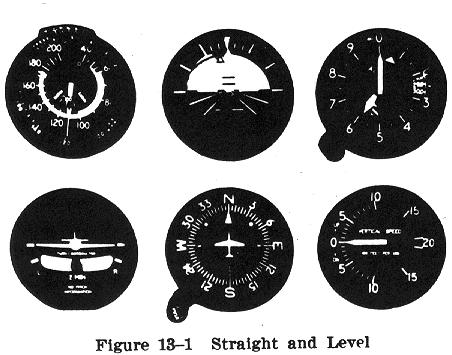Straight and Level
Straight and Level
| To maintain a straight flightpath, the pilot must keep
the airplane's wings level with the horizon. Any degree of bank (in coordinated
flight) will result in a deviation from straight flight, and a change in
the airplane's heading. If an attitude indicator is available, straight
flight is simplified by merely keeping the wings of the representative
airplane level with the representative or artificial horizon (Fig. 13-1).
This is accomplished by applying the necessary coordinated aileron and
rudder pressures.
The needle of a turn indicator or the representative wings on a turn
coordinator will deflect whenever the airplane is turned and will be centered
or level when the airplane is in straight flight. Thus, they also can be
used to maintain straight flight by applying coordinated aileron and rudder
pressures as needed to keep the needle centered or the turn coordinator's
airplane wings level. |
|
Regardless of which of these instruments is being used,
the heading indicator should be checked frequently to determine whether
a straight flightpath is actually being maintained. This is particularly
true when flying in turbulent air since every little gust may bank the
airplane and make it turn.
Using only the magnetic compass as a reference for maintaining
a straight course is difficult but is possible. Therefore, before using
the compass, the pilot must learn its characteristics.
When turning from a northerly heading, the compass will
lag behind the actual heading of the airplane and in fact, indicate a turn
in the opposite direction. The only general compass heading that accurately
indicates when and in which direction a turn is started, is southerly.
While the magnetic compass may be used to maintain a direction and detect
the start of a turn on any heading from approximately 120 degrees to 240
degrees, the pilot will find it easier to detect a turn on a heading of
south. On this heading when a turn is inadvertently started, the magnetic
compass exaggerates it and correctly shows in which direction the airplane
is turning. With practice, even in turbulence, the pilot can hold a reasonably
accurate heading in the southern portion of the compass card. Consequently,
relatively large movements of the compass should not be regarded with alarm.
The compass should be allowed to oscillate if turbulence makes it unavoidable.
Smooth and alert control action will result in a surprisingly small actual
deviation from desired heading.
At the same time that straight flight is being maintained,
the pilot must also control the pitch attitude to keep the airplane level
- that is, no gain or loss of altitude. This can be accomplished by reference
to several instruments.
The first is the altimeter, which tells when a constant
altitude is being maintained or if the flight altitude is changing. A vertical
speed indicator, when available, will indicate the rate at which altitude
is changing. Either of these instruments, therefore, shows the pilot whether
a change in pitch attitude is needed and approximately how much (Fig. 13-1).
Just as when flying by reference to outside visual references,
a change in altitude when level flight is desired, requires that the airplane's
nose be raised or lowered in relation to the horizon. This can be done
most easily with reference to the attitude indicator, by applying elevator
pressure to adjust the representative airplane in relation to the horizon
bar. The application of elevator pressure should be very slight to prevent
overcontrolling. It must be emphasized that turn coordinators provide NO
PITCH INFORMATION even though they have an appearance similar to attitude
indicators.
In lieu of an attitude indicator, the vertical speed indicator
may be used. However, if the instrument shows a climb or descent, the pilot
should apply only sufficient elevator pressure to start the pointer moving
toward the zero indication, since there is a certain amount of lag in the
indication. Trying to obtain an immediate zero indication usually results
in overcontrolling. When the pointer stabilizes again, additional pressure,
if needed, can then be added in increments to get a zero indication and
gradually stop the climb or descent. Only after the vertical speed is zero
and the altimeter remains constant should an attempt be made to return
to the original altitude.
In the case of an airplane having neither attitude indictor
nor vertical speed indicator, the airspeed indicator can be used much like
the vertical speed indicator to maintain level flight. Remember though
that it, too, lags somewhat as a result of the time required for the airplane
to accelerate and decelerate after a pitch change is made.
Pilots must be cautioned not to "chase" the pointers on
the instruments when flight through turbulent air produces erratic movements.
